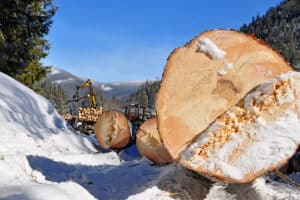For the last decade, EU foreign policy has created a major demand for wood pellets in Europe, and in recent years the U.S. has emerged as the world’s largest wood pellet exporter with the Southeast leading the way. Electric utility providers in several European nations seeking to avoid carbon taxes and adhere to mandated renewable energy thresholds are drawn to the abundance of timber, accessible ports, and low prices found along the Gulf & South Atlantic Coasts. In 2012, a few dozen mills from the region exported a little over one million tons of pellets – that number is expected to more than quadruple in 2015 with companies like Enviva LP, the nation’s largest pellet producer, investing hundreds of millions of dollars into new pellet mills. This new infrastructure, which will facilitate the export of a local natural resource, continues to foster a heated debate over the pros and cons of this growing industry.
The controversy surrounding the wood pellet industry is multi-faceted. Opponents claim that pellet mills are being supplied in large part by actual trees from clear cuts instead of residual wood debris from storm damage and common timber management harvest and that this practice is resulting in tremendous losses of wildlife habitat, water quality, & ecological diversity. A second argument suggests the reduction of carbon emissions realized from burning wood pellets instead of coal does not offset the loss of carbon absorption resulting from the deforestation. Supporters of wood biomass energy disagree, insisting that the demand for wood pellets has a positive impact on climate change because it influences landowners to continue growing timber as opposed to converting property into agriculture uses or developments. These proponents also dispute the notion that forest biomass energy production does more harm than good with regards to carbon emission with evidence that the emissions from biomass are a fraction of those resulting from burning fossil fuels. Pro-biomass groups simply reject the claim that saw timber logs are being used for biomass because of the financial loss a landowner would incur by selling his most valuable timber for pellet production as opposed to more common uses for this class of timber.
The EPA in the U.S. and the Department of Energy and Climate Change (DECC) in the United Kingdom have responded to strong opposition on both sides of the issue by taking a closer look at the sustainability of biomass energy production. Both agencies are on course to release updated reports that are certain to influence policy in the form of a more regulated industry and minimization of the negative impacts. Some environmental whistle blowers remain convinced that wood biomass is not a viable method for truly sustainable energy and are skeptical that new regulations will overcome the basic flaws they see in the foundation of this industry. Those in support of the growing wood pellet industry continue to express enthusiasm that wood biomass energy production is utilizing wood products that would otherwise go to waste as a sustainable energy source that is working to offset climate change.
With so much controversy & uncertainty surrounding the actual effects of wood biomass energy, the long term outlook for the wood pellet market is difficult to predict. Common ground can be found on both sides of the debate by focusing on a desire to create sustainable energy and reverse climate change. Whether these common interests can overcome the contrasting opinions remains to be seen and the position taken by the EPA and the DECC should play a major role in the future of this highly controversial industry.
This content may not be used or reproduced in any manner whatsoever, in part or in whole, without written permission of LANDTHINK. Use of this content without permission is a violation of federal copyright law. The articles, posts, comments, opinions and information provided by LANDTHINK are for informational and research purposes only and DOES NOT substitute or coincide with the advice of an attorney, accountant, real estate broker or any other licensed real estate professional. LANDTHINK strongly advises visitors and readers to seek their own professional guidance and advice related to buying, investing in or selling real estate.










While I do not agree with any aspects of the new religion of climate change; I do believe in the old adge of a fool and his money are soon parted. And frankly if European utilities are creating make-believe carbon credits while burning pine scraps from 3,000 miles away…I would be laughing all the way to the bank. America’s Southern forests used to export live oak and supplied the Royal Navy with warships for almost 200 years with solid timber from the Lowcountry coast. Then the highlands of North Carolina made 200 years worth of the finest furniture in the world…. Now folks are hustling pine bark scrap….and it goes up the furnace…. Think about it….
If in fact clear cut is being used than this is very, very wrong!